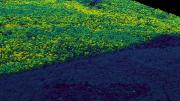Last summer—seemingly a lifetime ago—the news was dominated by reports of the escalation of human-created fires in the Amazon rainforest. For many readers, the Amazon fires brought awareness not just of the immense suffering deforestation inflicts on the people and animals who live there, but also of tropical rainforests’ role in maintaining a stable climate for the planet. Tropical forests hold about 25 percent of the world’s carbon in their trees and other plant species; when they’re burned, all of that carbon is emitted into the atmosphere—and all of the vegetation that acted as “carbon sinks” to absorb carbon disappears. Without rainforests, climate scientists warn, the global-warming consequences could be catastrophic.
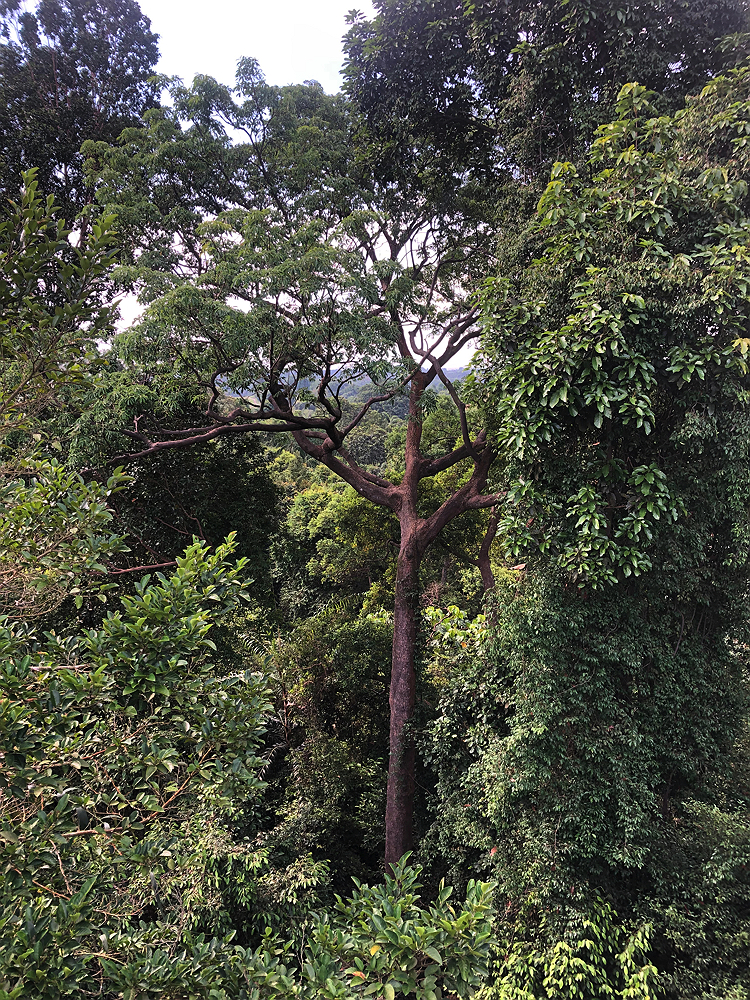
A tall tree in a forest in Bukit Timah, Singapore
Photograph by Elsa Ordway
Yet rainforest destruction continues unabated, not just in the South American Amazon, but also in Sub-Saharan Africa and Southeast Asia, to clear land for the cultivation of beef, timber, and oil crops like soy and oil palm. And deforestation doesn’t just impact species on the tracts that are directly burned—it’s also harmful to neighboring forestland still left standing in ways that scientists are only beginning to understand. In a study published this week in the Proceedings of the National Academy of Sciences, Elsa Ordway, a postdoctoral fellow at the Harvard University Center for the Environment, and co-author Greg Asner of Arizona State University mapped and measured these “edge effects” on rainforests that border oil-palm plantations in Malaysian Borneo. Forestland that was within about 100 meters of a boundary with a plantation, they found, showed a 22 percent decline in above-ground carbon compared to forest interiors, reflecting a reduced ability for trees there to store carbon.
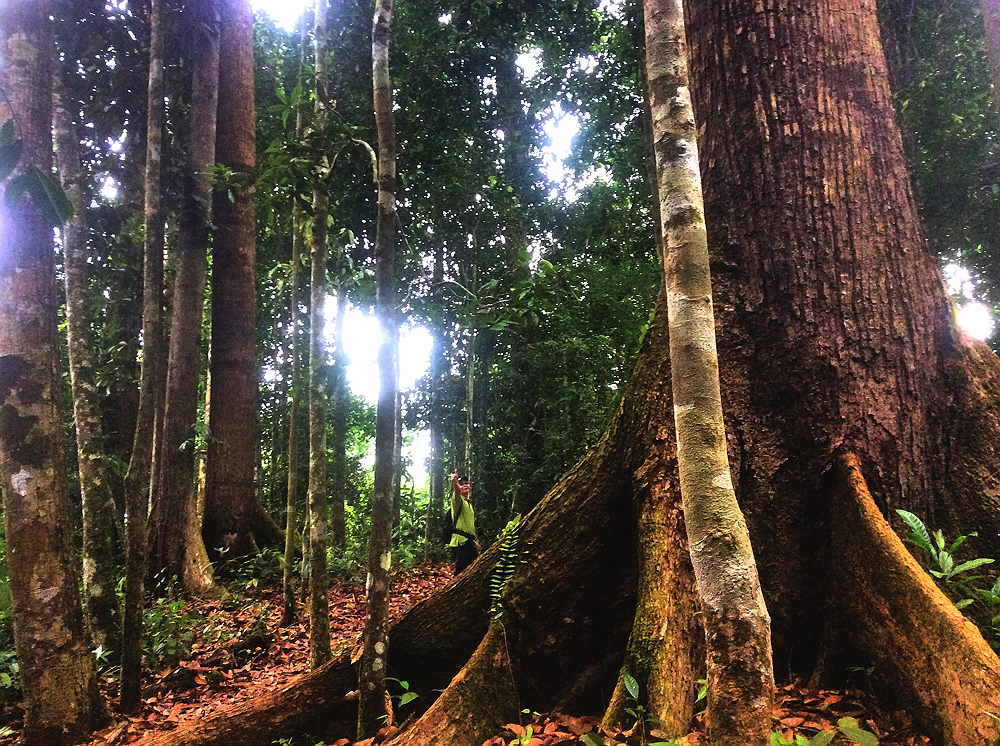
Large trees in forest in Sabah, Malaysia (note person for scale)
Photograph by Elsa Ordway
In Malaysia and Indonesia, rainforest destruction is driven by demand for palm oil, a vegetable oil used in processed foods like Oreos and chocolate bars, as well as lipsticks, shampoos, and other consumer products. It has severely endangered all three species of orangutans, the great apes found only in those countries, and other species. Widespread deforestation and forest fragmentation has left nearly 20 percent of the world’s tropical forest land within 100 meters of a forest edge.
Some of Ordway’s previous research has focused on the deforestation consequences of oil-palm farming in sub-Saharan Africa. The current study “is less focused on the fact that there are oil-palm plantations, and more focused on what’s going on in the forests next to them,” she explains. “This study looked at an example of that across Sabah, a Malaysian state in Borneo. We were trying to understand how much deforestation affects the remaining forests. Quite a bit, it seems like.” Even rainforests that are “set aside for conservation or left uncleared are still affected by the conversion of adjacent landscapes” into monoculture plantations, the study finds.
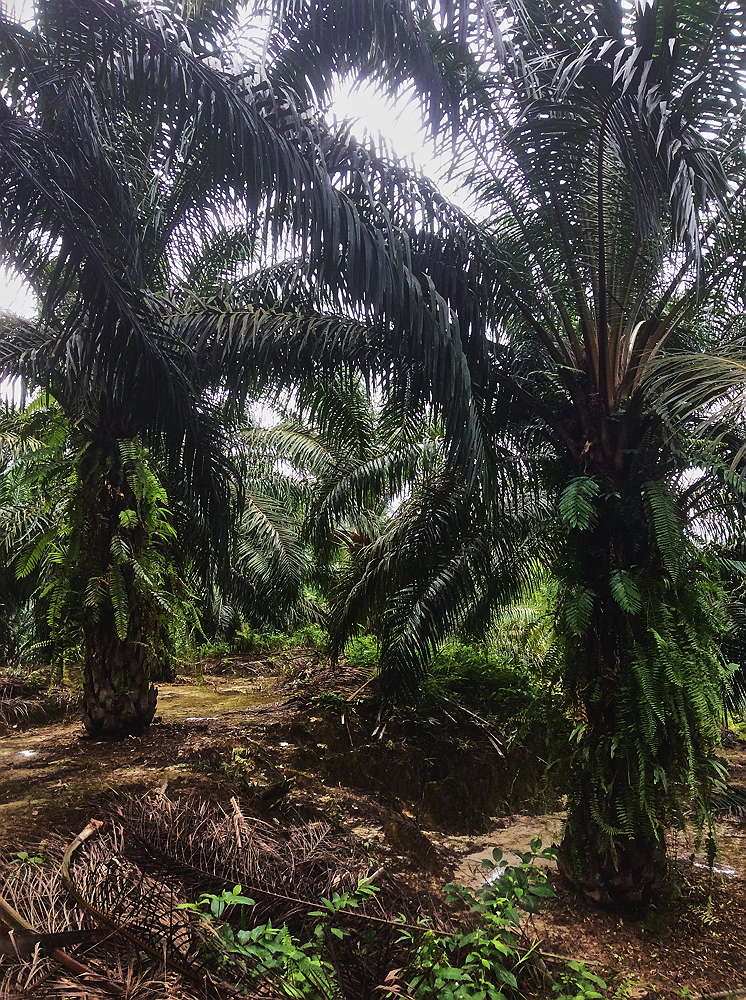
Oil palm trees in Sabah, Malaysia
Photograph by Elsa Ordway
“We have 10 years to maintain our terrestrial carbon sinks if the world has any hope of staying below 1.5 degree Celsius global average temperature rise,” Eric Dinerstein, a wildlife scientist who was not involved in the study, said in a news release. “The research presented here shows that a moratorium on forest conversion and emissions must occur even sooner than 2035,” the year by which scientists have said a moratorium on land conversion is required to avert the 1.5 degree Celsius warming threshold widely cited by the Intergovernmental Panel on Climate Change and others.
Previous research on rainforest “edge effects,” Ordway says, has depended either on local-scale field studies or on wider ranging but coarse data. With data collected by the Global Airborne Observatory developed by Asner, the team used high-fidelity imaging spectroscopy and light detection and ranging (LiDAR), technologies that allowed them to see what was going on in forests with much greater sensitivity. “Critically, the resolution and extent of these data allowed us to explore these questions both at” the level of individual plants, Ordway wrote in an email, “and across a large landscape scale, which is important because tropics forests vary enormously in plant function, tree species composition, and carbon flux dynamics. As a result, we were able to begin to uncover how these edge effects vary in space and time.”
What causes the degradation of forest edges? “It seems to vary a lot from one location to another,” Ordway says. The researchers found major changes in forest structure along boundaries with plantations. Sometimes decreases in aboveground carbon correspond to changes in the thick tree canopies that cover rainforests. Trees along edges can become vulnerable to wind gusts and increases in temperature, making them more prone to breakage and canopy gaps. Dense canopies normally mean that little light can penetrate into tropical forests; when gaps in the canopy let in more light, the entire ecosystem can change.
“But what was super interesting was that in most cases, we didn’t see an increase in those canopy gaps, which is what I thought would happen,” Ordway says. “Even along those areas where we don’t see an increase in canopy gaps, we still see that decline in carbon”—and other changes in tree traits like increased foliar phosphorus and decreased leaf mass per area. “We can’t get at the causal mechanism, but it’s indicative that something else is going on here. If it’s not a big canopy opening up, just the fact that the edge is there seems to be enough in terms of the light penetration, the changes in temperature, the changes in micro-meteorology—that’s enough just laterally penetrating into that forest to have an impact on aboveground biomass.”
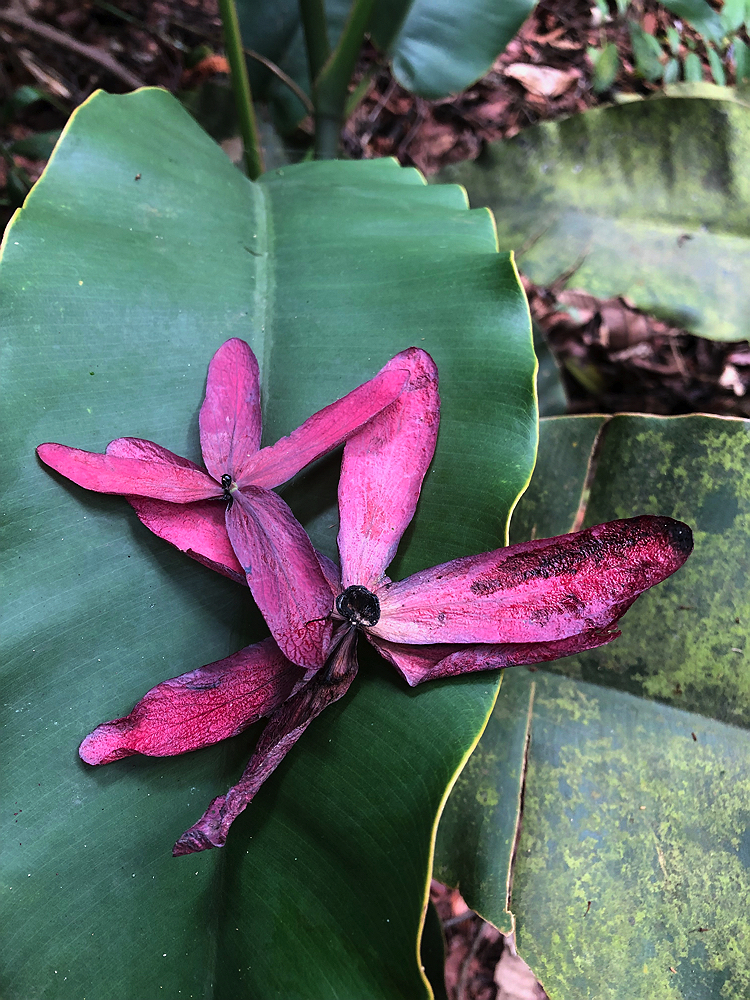
Flowers from a Shorea species, a tall tree genus that dominates Southeast Asian forests. The researchers are working to incorporate information about these trees in models to better predict what will happen to these forests in the future.
Photograph by Elsa Ordway
These findings suggest a need for “buffer zones” between forests and intensively farmed areas, Ordway says. “Examples of buffer zones include indigenous lands and forests with various levels of protection and multi-use around national parks,” she explains, “or leaving a perimeter of selectively logged forest around priority conservation areas.”
Rainforests’ role in managing global carbon is critical, but how they will respond to climate change is still uncertain, Ordway notes. At Harvard, she works with professor of organismic and evolutionary biology Paul Moorcroft (whose research in Amazonia was reported here) to use data like that used in this study to build better computer models of rainforests. “We know there’s a huge amount of variation in the species composition, the structure, the function” of different tropical forests across the world, she says. “There’s good reason to expect forests across the tropics may respond differently to climate change. We’re really interested in the heterogeneity across these landscapes, and how we can better incorporate that into these models so that we can better understand how different types of forests will respond.”
“Tropical forests are a really important part of the global carbon cycle, but there’s a huge amount of uncertainty as to what that’s going to look like in the future—whether they are going to be contributing to storing and sequestering carbon from the atmosphere, or whether they’re going to be emitting carbon dioxide to the atmosphere,” Ordway says. “We’re kind of at this precipice moment where we’re still very much trying to understand how they function—but at the same time, they’re changing rapidly.”
